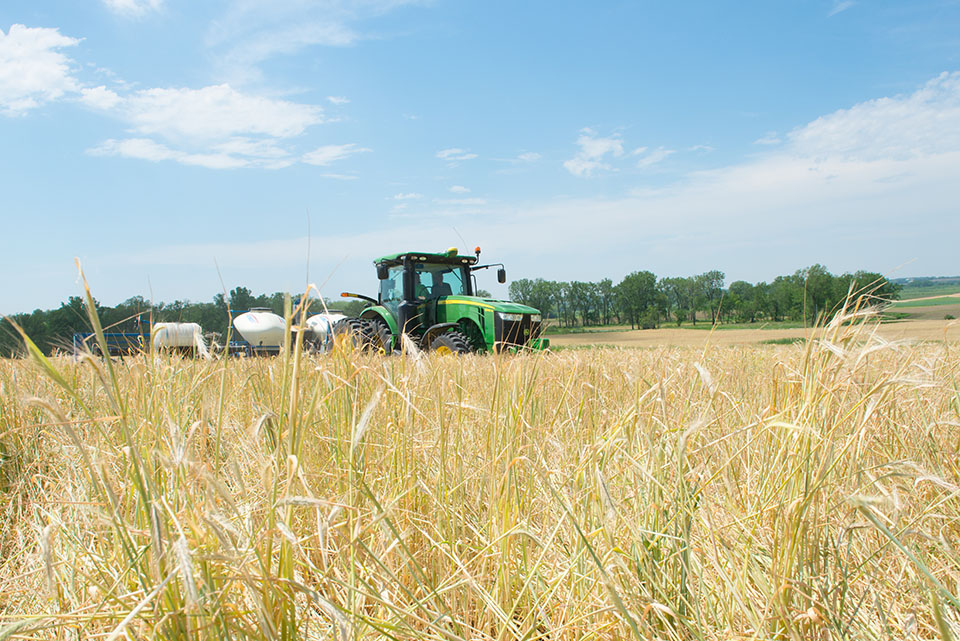
(Photo: Iowa Soybean Association / Joclyn Bushman)
Four tips for spring cover crop management
March 8, 2024 | Kriss Nelson
Spring cover crop management could have a direct impact on the success of your cash crop. Follow these four spring cover crop management tips as you prepare for the 2024 growing season.
Tip 1: Termination
Key things to consider when terminating cover crops are method and timing. “Termination seems to be the biggest hurdle — especially for newer adopters,” says Joe Wuebker, Iowa Soybean Association (ISA) conservation agronomist. “It is important to terminate as well as possible, knowing weather and other factors could impact your success.”
Chemical termination
With chemical termination, it is imperative to pay close attention to weather conditions and be ready to spray when conditions are prime.
“Spraying on a sunny day of 60-degree temperatures or higher with the following three days staying about 40 degrees would be optimal,” says Wuebker. “This can be difficult to hit sometimes, but it is a good guideline.”
When selecting the right herbicide, match the species to the chemical.
“Make sure you are picking something dependent on which type of cover crop species you have,” says Wuebker. “Do not cut back on rates and use the proper conditioners or adjuvants to give it your best shot the first time out.”
Mechanical termination
Crimping not only eliminates a herbicide pass, but it also leaves a decent amount of biomass, assisting with weed suppression in your cover crop.
Evan Brehm, ISA conservation agronomist, advises crimping a grass species of cover crops, such as cereal rye, once it has reached anthesis.
“This is when the cereal rye sheds pollen, which is highly visual,” says Brehm. “This is important because cereal rye will have a higher likelihood of being able to be terminated with a crimper.”
If crimping cereal rye after planting soybeans, Brehm suggests doing so before the soybean’s V3 growth stage.
“If soybeans grow much further, they could be more susceptible to injury,” says Brehm.

Tip 2: Planting Green
Much like termination, planting your cash crop into living cover crops, known as planting green, requires much consideration and planning.
Proper planter setup should involve considering down pressure, attachments for clearing trash, closing the trench properly and using a starter fertilizer.
Planting soybeans
Although planting soybeans into living cover crops can be done successfully, Brehm advises terminating the cover crop after three weeks of planting soybeans. After this time, the cover crop could tie up moisture, leaving it unavailable to the soybeans, and the cover crops could shade the growing soybeans from the sun.
Jim O’Connell, ISA farmer-member from Cedar Rapids, grows cover crops on every acre and plants green annually.
“I let the cover crops grow as tall as I can, depending on moisture, because I don’t want the soybeans to compete with the cover crops,” O’Connell says, adding he has planted soybeans into waist-high cereal rye.
So far, he has had no issues with soybeans germinating or uneven stands.
This method is saving O’Connell on herbicide passes.
“I have found the biomass from the cover crops suppresses weeds, and I have noticed some of those herbicide-resistant weeds do not like cereal rye,” says O’Connell. “I have several fields I am only having to spray once. I am cutting back a lot in herbicides.”
O’Connell has learned it’s best to wait for morning dew to dry off the cover crops before planting. Although watching his neighbors go early in the morning may be challenging, he has learned not to sweat it. He says he has the time because he has no other pre-planting field preparation.
“It makes the gauge wheels and everything wet on the planter. You pick up dirt, affecting the planting depth,” says O’Connell. “Be patient and wait until it dries up.”
Planting corn
Planting corn into standing cover crops, such as cereal rye, requires more management.
“It’s all about managing nitrogen,” says Brehm. “Farmers planting green into corn may need to set up their planter to put a starter fertilizer down because this is when the corn needs a little bit of a boost – even with all of that cereal rye.”
Brehm also suggests that farmers allow a week to 10 days after planting corn to terminate the cover crop.
O’Connell says he will plant corn into 14- to 16-inch high cereal rye. Once the corn germinates, he will terminate the cover crops.
“I found this works well for me. I don’t have to worry about nitrogen leaching from the cover crop hurting the corn from the allelopathic effect,” O’Connell says. “Normally, if you terminate the cover crop before you plant, you need to wait 10 to 14 days before planting.”
Tip 3: Managing Insects
Green fields in the early spring are often targets for insects. Often, it can be migrating insects and their eggs that will hatch when the cash crop is in its early growth stages and is extremely vulnerable to insect pressure.
“Proper scouting should be done around cover crop termination, planting and also through the first stages of growth and throughout the spring — especially in corn,” says Wuebker.
O’Connell’s planter is armed with insecticide to help battle any potential early-season insect pressure.
“We apply insecticide at corn planting using an in-furrow foam treatment, and it works really well,” O’Connell says.
Tip 4: Managing the Cash Crop
There isn’t much difference between corn and soybean management following cover crops versus traditional rotations, but Wuebker advises farmers to plan for the upcoming spring in the fall.
“Seeding mixes might be different based on which cash crop is being planted,” Wuebker says. “So the timing and your approach for termination and should be discussed in the fall before seeding.”
Spring nutrient management
Applying fertilizer with the planter or very close to planting might be ideal when corn is the cash crop.
“With all the plant material that is going to be out in the field, the carbon to nitrogen ratio gets thrown off, and we see higher amounts of nitrogen tie up in the soil,” says Wuebker. “Adding nitrogen makes it easier for the microbes in the soil to do their job and also for the corn to be more productive in its early stages of growth.”
O’Connell says he has learned cereal rye does not tap into nitrogen until it is 18 inches tall.
“I try to terminate the cereal rye at 16 to 18 inches before it does that, so I can get the most benefit out of that cover crop growing,” says O’Connell. “I have also read you could get an additional 30 units of late-season nitrogen for your corn from the decaying cover crop.”
“We’re still learning,” O’Connell says. “It’s trial and error every year.”
ISA’s conservation agronomy team is available to help set you up for success this spring. Email ISA Conservation Agronomy Lead Mike Gilman at mgilman@iasoybeans.com or call 515-577-5600.
Back